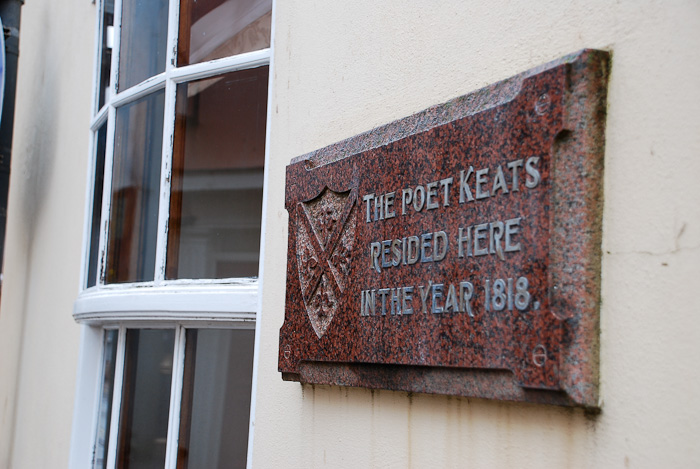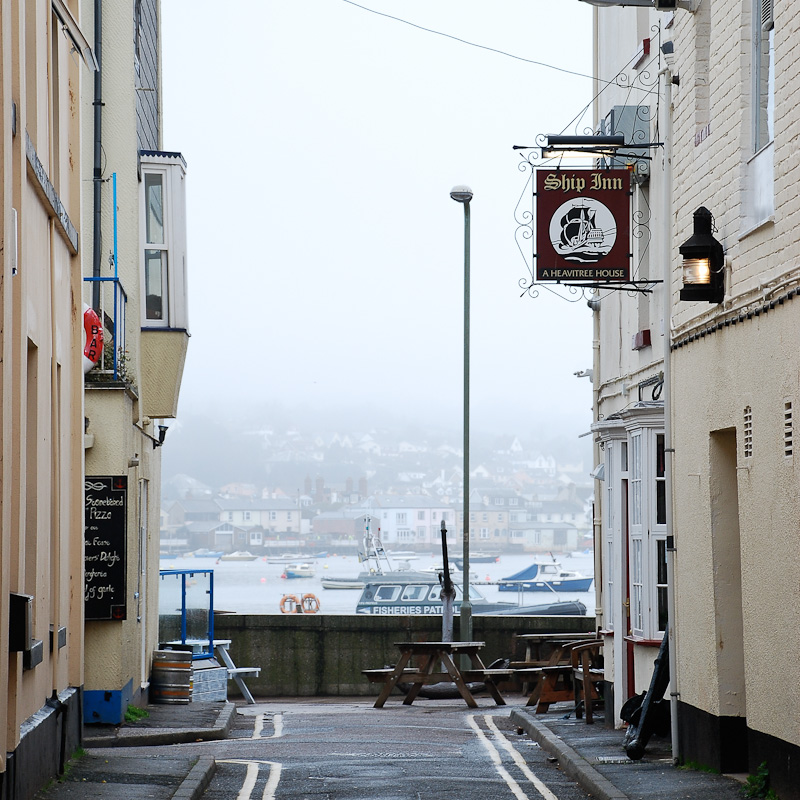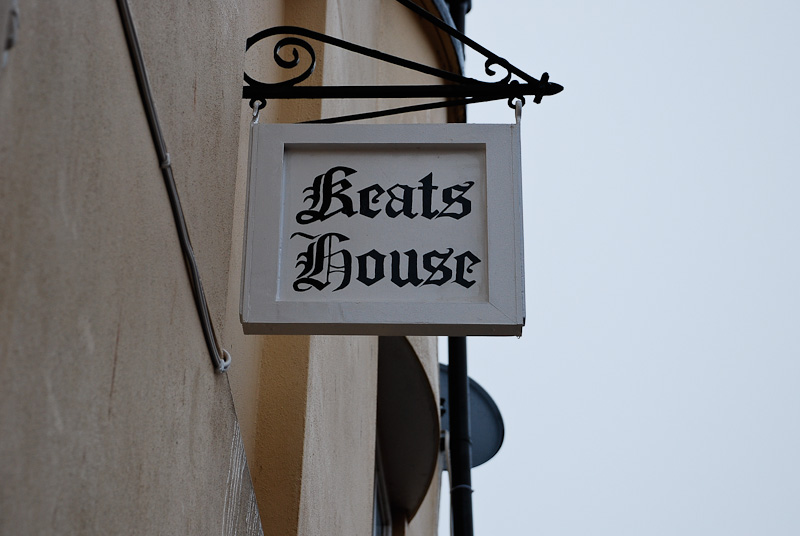‘Keats House’ in Northumberland Place may or may not be where John Keats lodged with the Jeffrey family during the two months that he spent in Teignmouth, caring for his ailing brother. Houses in the area have been renumbered many times since then, and in the early nineteenth-century the street was known as the Strand. From Keats’ letters it would seem that he stayed at a corner property with a view of the river, newly built on land reclaimed from a marsh. It sounds as if it would have been an uncomfortable place to spend the winter, even for a healthy person, and unlikely to enjoy the ‘very beneficial climate’ described in contemporary guidebooks.
Keats certainly gives the impression that the trip was something of a disappointment. He set off from London on 4 March, 1818, and the spring that year seems to have been a particularly wet one. Descriptions of the gloomy weather crop up repeatedly in letters to his friends:
March 13, to Benjamin Bailey –
– by the by you may say what you will of Devonshire: the truth is, it is a splashy, rainy, misty snowy, foggy, haily floody, muddy, slipshod county – the hills are very beautiful, when you get a sight of ‘em – the Primroses are out, but then you are in – the Cliffs are of a fine deep Colour, but then the Clouds are continually vieing with them –
March 14, to J. H. Reynolds –
– Being agog to see some Devonshire, I would have taken a walk the first day, but the rain would not let me; and the second, but the rain would not let me; and the third: but the rain forbade it – Ditto 4, ditto 5 – So I made up my Mind to stop in doors, and catch a sight flying between the showers; and behold I saw a pretty valley – pretty cliffs, pretty Brooks, pretty Meadows, pretty trees, both standing as they are created and blown down as they are uncreated – The green is beautiful as they say, and pity it is that it is amphibious – mais! but alas! the flowers here wait as naturally for the rain twice a day as the Muscles do for the Tide –
April 9, to J. H. Reynolds –
– Devonshire continues rainy. As the drops beat against the window, they give me the same sensation as a quart of cold water offered to revive a half drowned devil – No feel of the clouds dropping fatness; but as if the roots of the Earth were rotten cold and drench’d – I have not been able to go to Kents’ Cave at Babbicun – however on one very beautiful day I had a fine clamber over the rocks all along as far as that place: I shall be in Town in about Ten days – We go by way of Bath on purpose to call on Bailey –
27 April, to J. H. Reynolds –
We are here still enveloppd in clouds – I lay awake last night – listening to the Rain with a sense of being drown’d and rotted like a grain of wheat – There is a continual courtesy between the Heavens and the Earth. – the heavens rain down their unwelcomeness and the Earth sends it up again to be returned to morrow.
Queen Street and the River Teign photographed from Northumberland Place in March 2010.
* * * * *
A search of the web, along with a study of Keats’ published letters and poems, suggests that a list of his Teignmouth writings would include the following:
Letters to various correspondents dated between 13 March and 3 May 1818.
‘The Human Seasons’ – in a letter to Benjamin Bailey, 13/03/1818.
‘Over the hill and over the dale’ (also known as ‘Dawlish Fair’) – letter to James Rice, 24/03/1818. (See below for a more complete version of this poem.)
‘Epistle to John Hamilton Reynolds’ – 25/03/1818.
‘Isabella’, stanzas 12, 13 and 30 – letter to J. H. Reynolds, 27/04/1818.
‘Mother of Hermes! and still youthful Maia!’ – letter to J. H. Reynolds, 03/05/1818.
DAWLISH FAIR
Over the hill and over the dale,
And over the bourn to Dawlish–
Where gingerbread wives have a scanty sale
And gingerbread nuts are smallish.
Rantipole Betty she ran down a hill
And kicked up her petticoats fairly
Says I I’ll be Jack if you will be Gill–
So she sat on the grass debonairly.
Here’s somebody coming, here’s somebody coming!
Says I ’tis the wind at a parley;
So without any fuss any hawing and humming
She lay on the grass debonairly.
Here’s somebody here and here’s somebody there!
Says I hold your tongue you young Gipsey;
So she held her tongue and lay plump and fair
And dead as a venus tipsy.
O who wouldn’t hie to Dawlish fair,
O who wouldn’t stop in a Meadow,
O who would not rumple the daisies there
And make the wild fern for a bed do!
* * * * *
MORE LINKS AND FURTHER READING
The Rise of the Devon Seaside Resorts, 1750-1900, by John Travis, is available to read online at Google books and provides a useful insight into the over-optimistic promises held out to encourage invalids and their families to spend the winter at the coast.
According to the Thomas Luny House website, Andrew Motion used to bring his family to the town for holidays, so is presumably well-placed to comment on its advantages and drawbacks – his biography of Keats offers an excellent account of the Teignmouth episode.
Ideas of landscape in John Keats’ Teignmouth poems: an article by Clayton G. Mackenzie. Note – If Keats did visit Shaldon, as suggested by the author of this piece, he would have travelled by ferry. The first bridge wasn’t constructed until 1827.
Text and photos © Angela Williams, 2010, 2011



